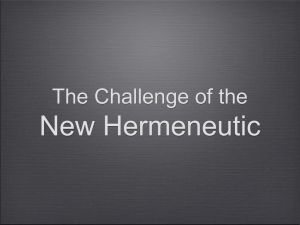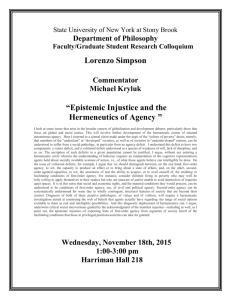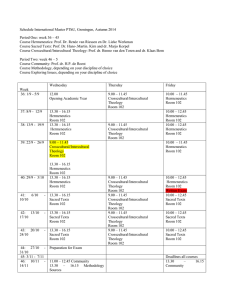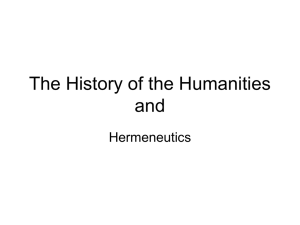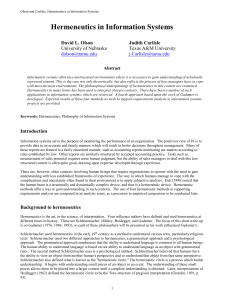Introduction to Hermeneutics - Colonel By Secondary School
advertisement
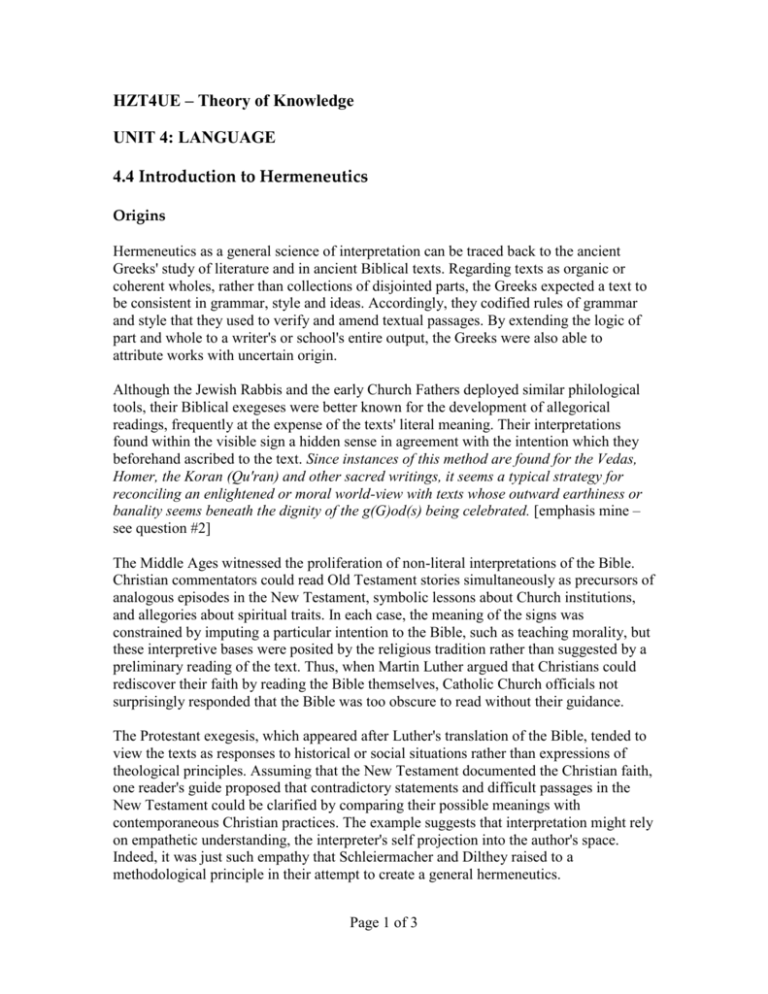
HZT4UE – Theory of Knowledge UNIT 4: LANGUAGE 4.4 Introduction to Hermeneutics Origins Hermeneutics as a general science of interpretation can be traced back to the ancient Greeks' study of literature and in ancient Biblical texts. Regarding texts as organic or coherent wholes, rather than collections of disjointed parts, the Greeks expected a text to be consistent in grammar, style and ideas. Accordingly, they codified rules of grammar and style that they used to verify and amend textual passages. By extending the logic of part and whole to a writer's or school's entire output, the Greeks were also able to attribute works with uncertain origin. Although the Jewish Rabbis and the early Church Fathers deployed similar philological tools, their Biblical exegeses were better known for the development of allegorical readings, frequently at the expense of the texts' literal meaning. Their interpretations found within the visible sign a hidden sense in agreement with the intention which they beforehand ascribed to the text. Since instances of this method are found for the Vedas, Homer, the Koran (Qu'ran) and other sacred writings, it seems a typical strategy for reconciling an enlightened or moral world-view with texts whose outward earthiness or banality seems beneath the dignity of the g(G)od(s) being celebrated. [emphasis mine – see question #2] The Middle Ages witnessed the proliferation of non-literal interpretations of the Bible. Christian commentators could read Old Testament stories simultaneously as precursors of analogous episodes in the New Testament, symbolic lessons about Church institutions, and allegories about spiritual traits. In each case, the meaning of the signs was constrained by imputing a particular intention to the Bible, such as teaching morality, but these interpretive bases were posited by the religious tradition rather than suggested by a preliminary reading of the text. Thus, when Martin Luther argued that Christians could rediscover their faith by reading the Bible themselves, Catholic Church officials not surprisingly responded that the Bible was too obscure to read without their guidance. The Protestant exegesis, which appeared after Luther's translation of the Bible, tended to view the texts as responses to historical or social situations rather than expressions of theological principles. Assuming that the New Testament documented the Christian faith, one reader's guide proposed that contradictory statements and difficult passages in the New Testament could be clarified by comparing their possible meanings with contemporaneous Christian practices. The example suggests that interpretation might rely on empathetic understanding, the interpreter's self projection into the author's space. Indeed, it was just such empathy that Schleiermacher and Dilthey raised to a methodological principle in their attempt to create a general hermeneutics. Page 1 of 3 The Methodological Hermeneutics of Schleiermacher and Dilthey Schleiermacher compared the reader's approach to a text with the efforts by participants in a dialogue to understand each other, and he depicted the dialogue in terms of a speaker who puts together words to express his thoughts and a listener who understands this speech as part of a shared language and as part of the speaker's thinking. The listener can comprehend the words and sentences because they are drawn from the language's lexicon and follow its grammatical rules, but the listener can also recognize the intentions behind the words by virtue of being in the same situation and sharing a common human nature with the speaker. Since Schleiermacher's concept of understanding includes empathy (projective introspection) as well as intuitive linguistic analysis, it is much richer than the idea in modern communication theories that understanding is merely the decoding of encoded information. Interpretation is built upon understanding and has a grammatical, as well as a psychological moment. In the psychological thrust the interpreter reconstructs and explicates the subject's motives and implicit assumptions. Thus Schleiermacher claimed that a successful interpreter could understand the author as well, as or even better than, the author understood himself because the interpretation highlights hidden motives and strategies. Broadening Schleiermacher's hermeneutics, Dilthey developed a philosophy of method for history and the human sciences that he believed could produce objective knowledge but avoid the reductionist, mechanistic, ahistorical explanatory schema of the natural sciences. Dilthey argued that texts, verbal utterances, art and actions were meaningful expressions whose “mental contents” or intentions needed to be comprehended. He claimed that investigating human interactions was more like interpreting a poem or discourse, rather than doing physics or chemistry experiments. Dilthey emphasized that texts and actions were as much products of their times as expressions of individuals, and their meanings were consequently constrained by both an orientation to values of their period and a place in the web of their authors' plans and experiences. In this revision, meanings are delineated by the author's weltanschauung, or world-view, reflecting a historical period and social context. Understanding (verstehen), the basis for methodological hermeneutics, involves tracing a circle from text to the author's biography and immediate historical circumstances and back again. Interpretation, or the systematic application of understanding to the text, reconstructs the world in which the text was produced and places the text in that world. -------------------------------------------------------------------------------- Recent debates about the theoretical foundations of Artificial Intelligence (AI) refer to hermeneutics, the branch of continental philosophy which treats the understanding and interpretation of texts. This idea helps AI researchers in their investigations of the structure of texts and in their concern with creating rules for identifying language meaning in AI. Some researchers pursue a classical hermeneutical program tempered by phenomenological hermeneutics [more on this later – Mr. Vitzthum]. Other researchers draw from hermeneutics to propose strategies for developing computer systems that understand natural language. A third approach argues that computer understanding of Page 2 of 3 natural language is exceedingly difficult and probably intractable. Ironically, these critics also use hermeneutics to support their position. Hermeneutic theories differ in several characteristic ways from approaches to meaning and understanding which are better known to traditional AI researchers. Hermeneutics grounds the meaning of texts in the intentions and histories of their authors and/or in their relevance for readers. Hermeneutics regards texts as means for transmitting experience, beliefs and judgments from one subject or community to another. Hence the determination of specific meanings is a matter for practical judgment and common sense reasoning - not for apriori theory and scientific proof. Hermeneutic theories and applications also share the idea of the hermeneutic circle or the notion that understanding or definition of something employs attributes which already presuppose an understanding or a definition of that thing. Circles or spirals of understanding arise in interpreting one's own language, a foreign language or an observed action, in confirming a theory and in distinguishing between background knowledge and facts. The philosophical concept of the hermeneutic circle resembles the distinctly computational notion of bootstrapping - a process which uses a lower order component (a bootstrap component) to build a higher order component that is used in turn to reconstruct and replace the lower order component. Bootstrapping has been introduced in the design of certain knowledge bases and in AI-oriented theories of cognitive development or "learning". The similarity of the hermeneutic circle and bootstrapping suggests the possibility of an important contribution from hermeneutics to AI architectures for natural language processing and for common-sense reasoning. Source: Largely from <http://www.ai.mit.edu/people/jcma/papers/1986-ai-memo-71/tableofcontents3_1.html> Questions on Hermeneutics: 1. How was hermeneutics used by the Greeks for anonymous texts? 2. Perform your own hermeneutics for me by interpreting the last sentence of the second paragraph (in italics). 3. How did the Catholic church respond to Martin Luther's suggestions? How did Luther respond? Whom do you agree with? 4. What is the relevance of empathy for Schleiermacher? 5. What is weltanschauung? 6. Explain how the hermeneutic circle relates to the AI idea of bootstrapping. Give one example of this happening in the real world. Page 3 of 3

